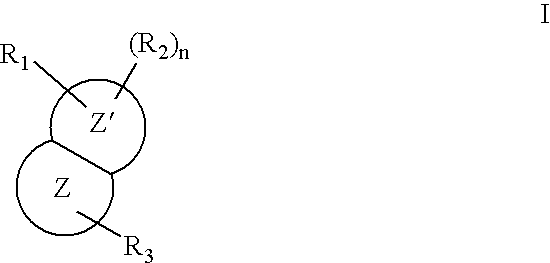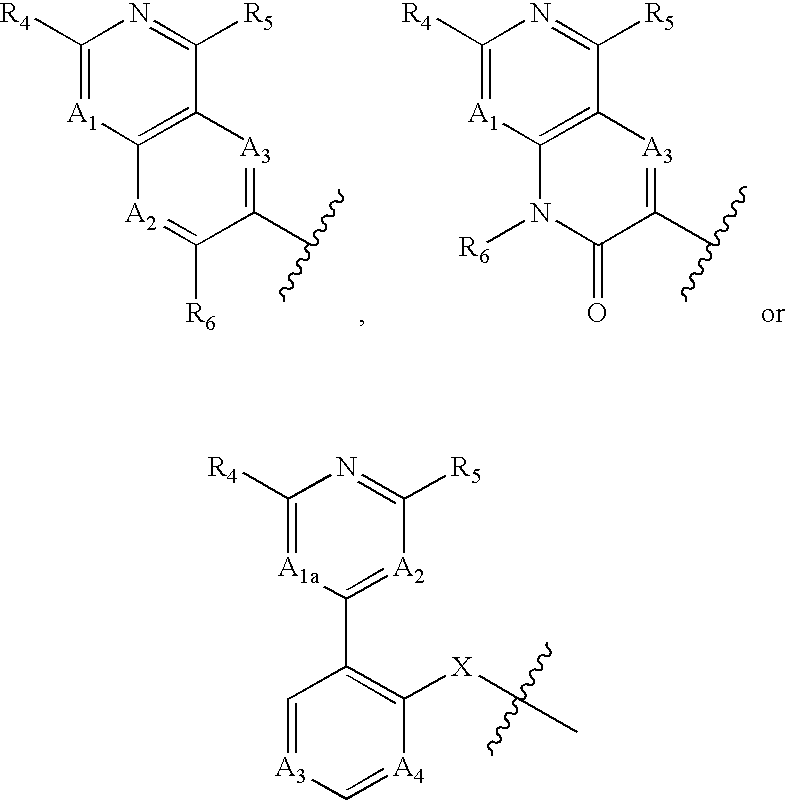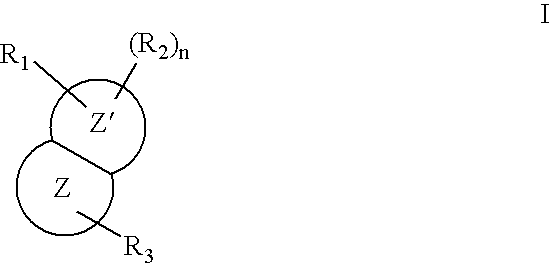Nitrogen-containing bicyclic heteroaryl compounds and methods of use
a technology of bicyclic heteroaryl compounds and compounds, applied in the field of pharmaceutical agents, can solve the problems of few offering any considerable degree of success, and the major cause of death worldwid
- Summary
- Abstract
- Description
- Claims
- Application Information
AI Technical Summary
Benefits of technology
Problems solved by technology
Method used
Image
Examples
example 1
Preparation of 6-methyl-5-nitroisoquinoline
Step 1
[0302] 4-Methyl benzaldehyde (1641 ml, 13878 mmol) and 2,2-dimethoxyethanamine (1497 ml, 13878 mmol) were added to a 12 L round bottomed flask equipped with a mechanical stirrer, heating mantle, and Dean-Stark trap with condenser. (Note: The reaction exothermed with this addition immediately to 70° C.). The mixture was then gradually heated to 190° C. Water started to distill off vigorously around 105° C. The reaction was then azeotroped with toluene (400 mL). The Dean-Stark trap was replaced by a short path distillation apparatus to remove toluene more quickly. The crude product (2870 g, 100%) was used in the next step as is.
Step 2
[0303] The product from step 1 in a 12L round bottomed flask equipped with a overhead stirrer and cooling condenser containing was treated with methanol (3.8 L). Sodium borohydride (511 g, 13.5 mol) was added in small portions (15 g at a time) whilst maintaining an internal reaction temperature betwee...
example 2
Preparation of 6-methyl-5-nitroisoquinoline-N-oxide
[0306] 6-Methyl-5-nitroisoquinoline (100.0 g, 531 mmol) in Dichlormethane (1 L) was added to a 2 L 3-necked round bottomed flask and cooled to 5° C. Purified m-chloroperoxobenzoic acid (129 g, 749 mmol) was added to this stirred solution [m-CPBA was extracted with saturated Phosphate buffer pH 7.5 and DCM]. Initially with the addition of mCPBA the reaction exothermed, but then endothermed to 2° C. After 20 min, the contents in the flask solidified to a yellow / white solid and more DCM (300 mL) was added. The reaction was allowed to stir overnight at room temperature. DCM (2 L) was added and the mixture washed with 1 N NaOH (1 L), saturated sodium bicarbonate (1 L) and brine (1 L). The solution was dried over sodium sulfate and concentrated to give 6-methyl-5-nitroisoquinoline-N-oxide (81.7 g, 75%). MS (M+H)+ 205.
example 3
Preparation of 1-chloro-6-methyl-5-nitroisoquinoline
[0307] 6-Methyl-5-nitroisoquinolin-1(2H)-one-N-oxide (3.1 g, 15.2 mmol) was taken up in chloroform (100 mL) and phosphorus oxychloride (7 mL, 80 mmol) was added dropwise to the reaction. The mixture was then heated to 70° C. After 3 h, the reaction was cooled and the volatiles removed in vacuo. Residual phosphorus oxychloride was azeotroped with toluene. The residue was then dissolved in chlorofom and washed with cold water, saturated NaHCO3 and brine. The organic layer was then dried with sodium sulfate and purified by column chromatography using 10 to 40% ethyl acetate in hexanes as an eluent. The title compound was obtained an off-white solid (3.4 g, 96%). MS (M+H)+223.
PUM
| Property | Measurement | Unit |
|---|---|---|
| Volume | aaaaa | aaaaa |
| Volume | aaaaa | aaaaa |
| Mass | aaaaa | aaaaa |
Abstract
Description
Claims
Application Information
 Login to View More
Login to View More - R&D
- Intellectual Property
- Life Sciences
- Materials
- Tech Scout
- Unparalleled Data Quality
- Higher Quality Content
- 60% Fewer Hallucinations
Browse by: Latest US Patents, China's latest patents, Technical Efficacy Thesaurus, Application Domain, Technology Topic, Popular Technical Reports.
© 2025 PatSnap. All rights reserved.Legal|Privacy policy|Modern Slavery Act Transparency Statement|Sitemap|About US| Contact US: help@patsnap.com



